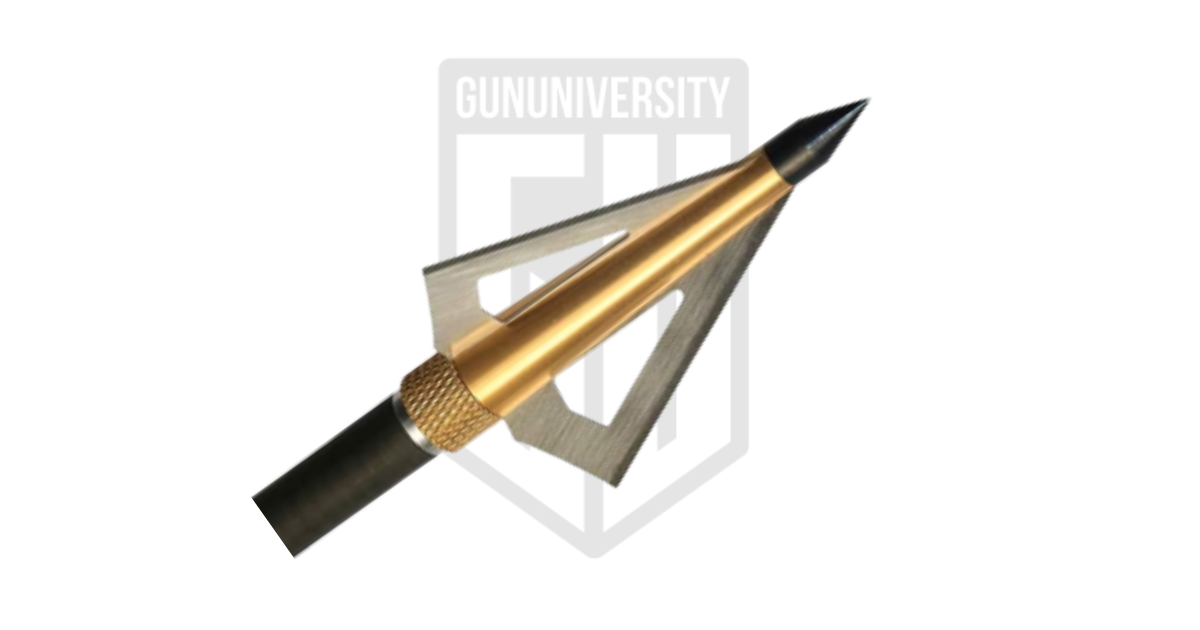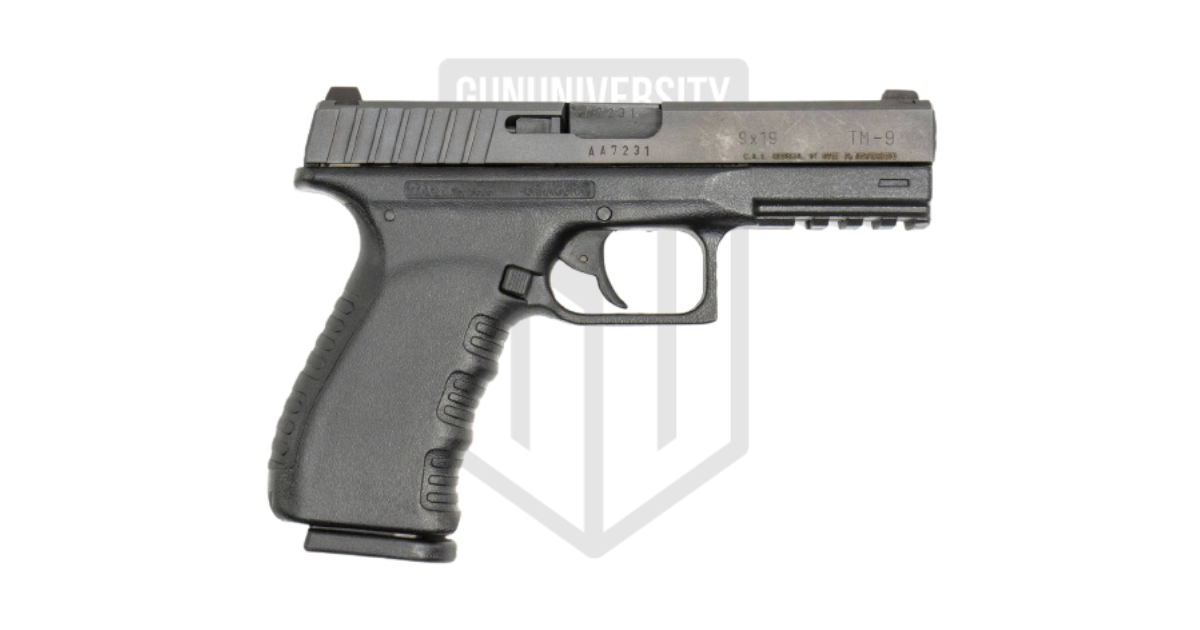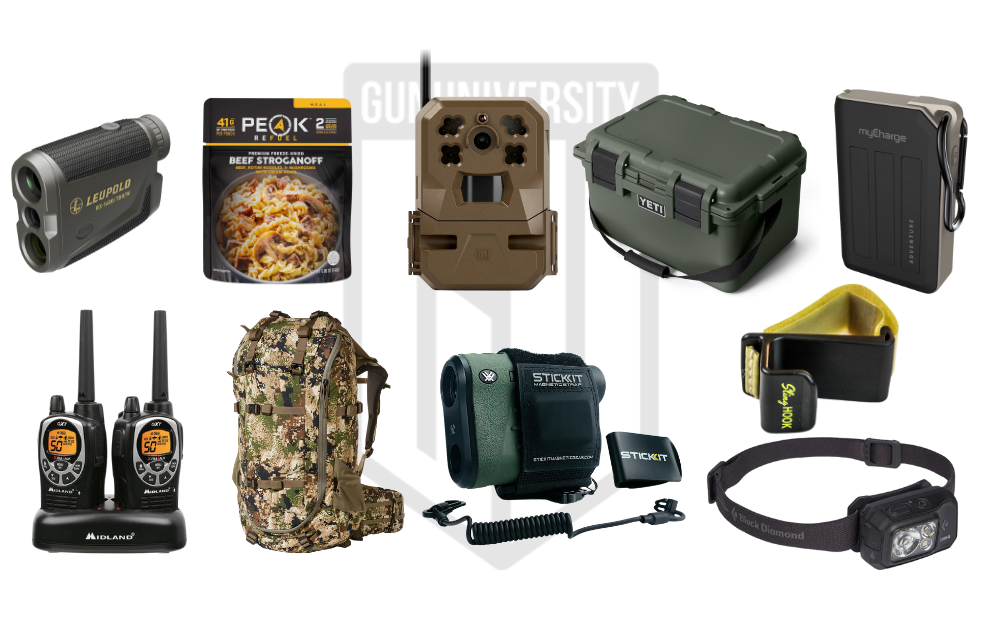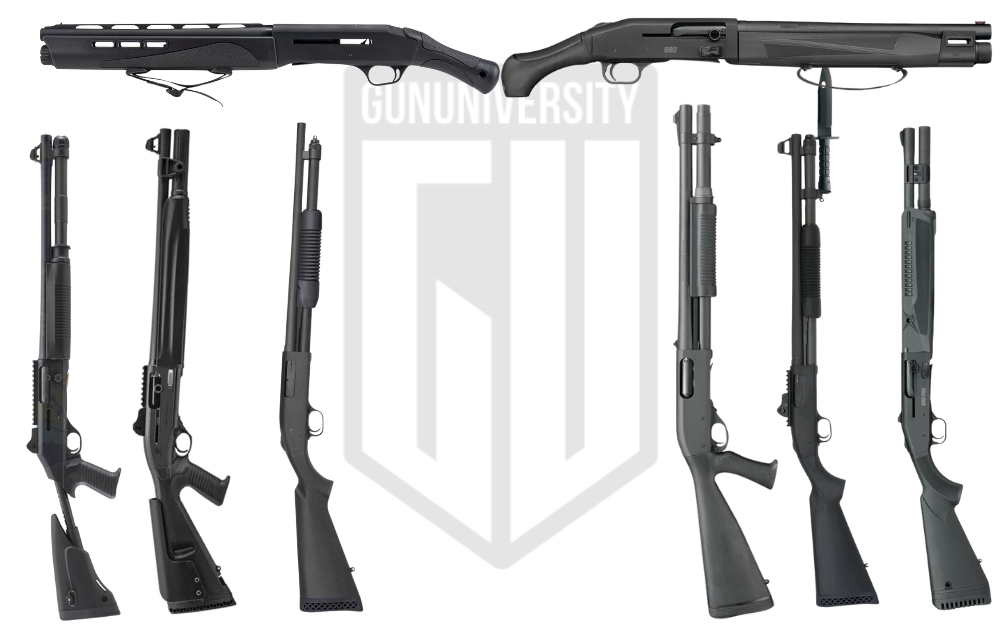5 Best Fixed Blade Broadheads: Finding the Right One For You!
The chances of you making a kill on your hunts depend on how accurate you are, how well your equipment is tuned, and the type of broadhead you use. For this reason, all hunters take broadheads very seriously and I’m no different. I use both fixed and mechanical broadheads, but if I had to choose, I’d go with a fixed blade broadhead.
Fixed blade broadheads are great to use for two reasons. One, I like how reliable they are and if I’m taking a make or break shot, I would always go for my fixed blade broadhead over a mechanical one. Two, they are a lot more simple to handle. But not every fixed blade broadhead out there would be a good fit for you, I had to go through several to find ones that I liked, too.
That’s why I know choosing the right broadhead for you can be stressful; there’s so much to consider, including the game you hunt, shooting conditions, and personal preferences. So, I’ve put together a list of the best fixed blade broadheads I’ve used. Broadheads are a very personal choice; what works for one person may not work for the other and vice versa. My advice here is to read the reviews and then go try them out for yourself until you find the one that’s right for you.
How I Chose The Best Fixed Broadheads
As someone who has been hunting for over 25 years, I’ve tried out many fixed blade broadheads on different hunting grounds. Testing them out has been a big part of my hunting trips. From the woods to open fields, each place brought its own challenges, helping me figure out which broadheads work best.
So, I put together this article with the fixed blade broadheads that have been doing the job for me. It’s not just my take. I got some insights from my hunting buddies and family who love it as much as I do. When testing the fixed blade broadheads, I considered things like sharpness, penetration, flight, and value.
Just a heads up, not all fixed blade broadheads are the same. It took a few tries to figure out which ones worked for me. Your preferences might be different, so what worked for me might not work for you.
That’s why I’ve lined up a bunch of fixed blade broadheads, each with its own perks, so there’s something for everyone. Here’s a quick rundown of every fixed blade broadhead I’ve picked.
Gun University’s Choices of the Best Fixed Blade Broadheads
Best Fixed Blade Broadheads
Best Overall G5 Outdoors Montec | 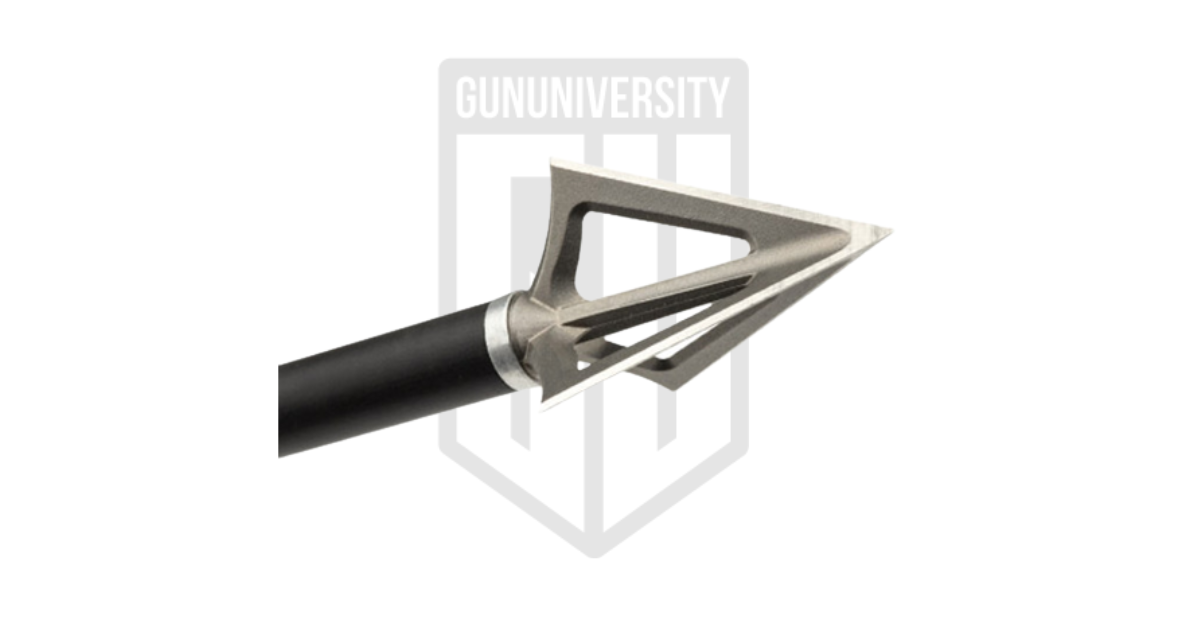 |
| Buy on Amazon |
Best for small to medium-sized game QAD Exodus | 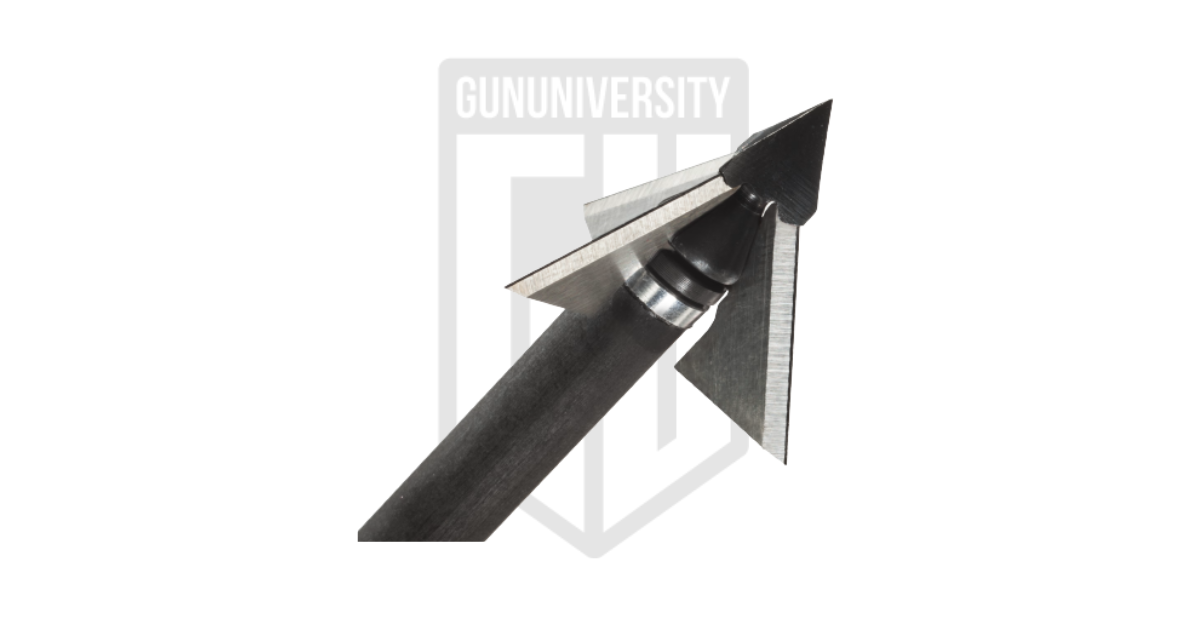 |
| Buy on Amazon |
Best For Large Game Muzzy Trocar | 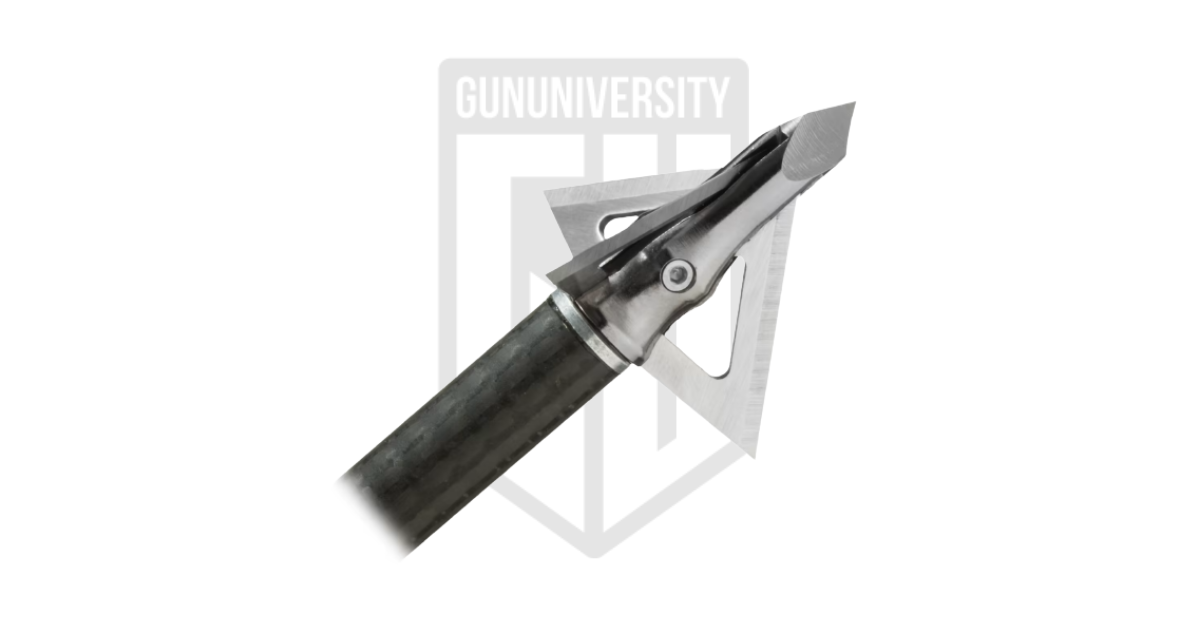 |
| Buy on Amazon |
Best blood trail Magnus 4-Blade Hornet |  |
| Buy on Amazon |
Best budget Huntingdoor Three Blade | 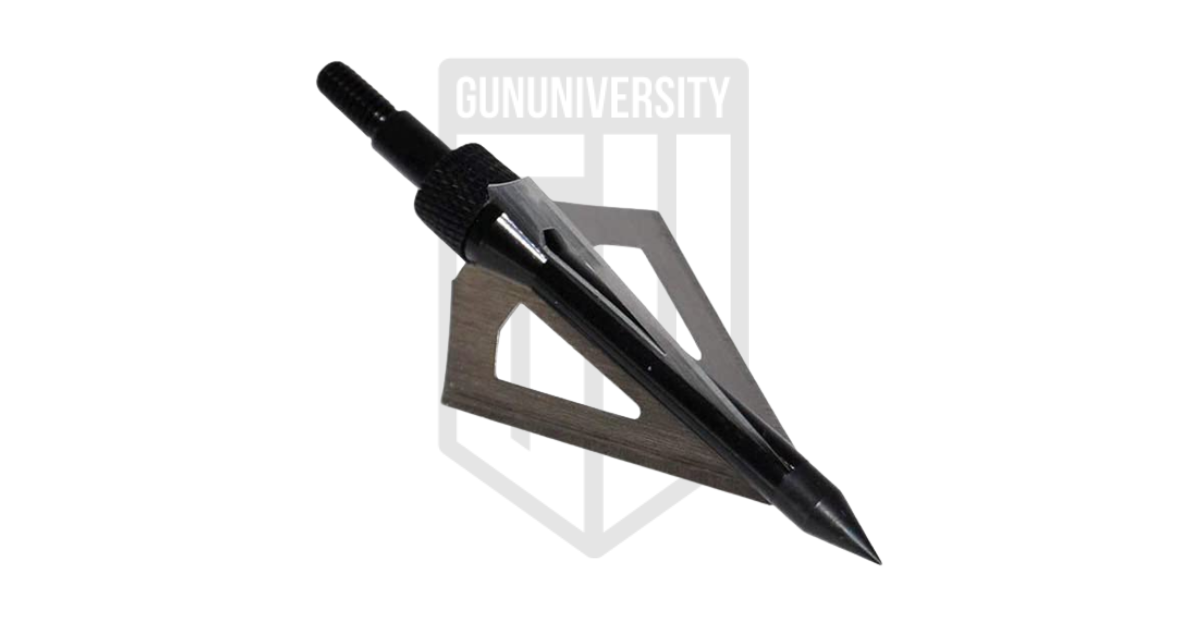 |
| Buy on Amazon |
Best Fixed Blade Broadheads Specifications
Below is a table of the specs for each broadhead. Click the name of the item to jump to that review.
| Broadhead | Number of Blades | Weight (grains) | Blade Thickness (in) | Cutting Diameter (in) |
|---|---|---|---|---|
| G5 Outdoors Montec | 3 | 85/100/125 | 0.030 | 1/1.0625/1.125 |
| QAD Exodus | 3 | 85/100/125 | 0.040 | 1.25 |
| Muzzy Trocar | 3 | 100 | 0.035 | 1.1875 |
| Magnus 4-Blade Hornet | 4 | 100/125 | Main Blade 0.059/Bleeder Blade 0.040 | 1.25 |
| Huntingdoor Three Blade | 3 | 125 | 0.0157 | 1.07 |
Best Fixed Blade Broadheads
Here is our list for the best fixed blade broadheads:
Best Fixed Blade Broadheads – Reviews
Here are the detailed reviews of all the broadheads I’ve listed along with a side-by-side spec table on each. While they are all good broadheads, I feel that some of them have certain standout features that make them the best for their category.
Best Overall G5 Montec
G5 Montec
3 blade fixed blade broadhead made from steel available in 85, 100, and 125 grains.
- Sharpness B-
- Penetration A
- Flight A+
- Value A+
Our Grade
A
Reader’s Grade
B-
Based on 2 Reviews
Your Grade
Do You Own This Accessory? Leave A Review
Success Your Grade Has Been
Added To Our Reader’s Score
We use email to verify the accuracy of our reviews. We promise to never spam you.
G5 Outdoors Montec Specs
- Number of Blades 4
- Weight (Grains) 85/100/125
- Blade Thickness (in) 0.030
- Cutting Diameter (in) 1/1.0625/1.125
G5 Outdoors Montec Review
The G5 Outdoors Montec is my best overall pick for fixed blade broadheads. It’s a simple, one-piece stainless steel deal with three killer blades. It has no issues with the moving parts and is easy to sharpen. The only downside is that if a blade breaks, you can’t swap it out. But it’s not really a deal breaker for me because the G5 Montec broadheads are built to last.
The Montec comes in different weights, from 85 to 125 grains, so they work with almost any crossbow and bolt. I’ve got various crossbows, each with its own specs, and these broadheads are great for that versatility.
Go for the 125-grain Montec, and you’re looking at a 1⅛ inch cutting diameter, it gives you a good blood trail. They’re affordable, durable, and you can use them over and over again. It is a smart buy for any crossbow hunter.
The cut-on-contact tip is the real deal, it effortlessly slices through muscle and sinews. You just have to be accurate, because hitting hard bones could throw it off. These blades aren’t the sharpest, but a quick sharpening fixes that and I always do it before my hunts.
I wish they had a 150-grain option for heavier games, but the 125-grain version’s versatility and power make it my best overall broadhead choice.
G5 Outdoors Montec Pros and Cons
- 3 weight options
- Single-piece injection molding
- Durable design
- High reusability
- Not the sharpest
Best for Small to Medium Game QAD Exodus
QAD Exodus
3 blade fixed blade broadhead made from stainless steel with replaceable blades available in 85, 100, and 125 grains.
- Sharpness A
- Penetration A+
- Flight A
- Value B-
Our Grade
A-
Reader’s Grade
B
Based on 2 Reviews
Your Grade
Do You Own This Accessory? Leave A Review
Success Your Grade Has Been
Added To Our Reader’s Score
We use email to verify the accuracy of our reviews. We promise to never spam you.
QAD Exodus Specs
- Number of Blades 3
- Weight (Grains) 85/100/125
- Blade Thickness (in) 0.040
- Cutting Diameter (in) 1.25
QAD Exodus Review
If you are after a medium-sized game like Whitetail Deer, I highly recommend going with the QAD Exodus. It’s an accurate three-blade broadhead that has a large cutting diameter.
What caught my eye was its “blade over shaft” design, making it one of the most compact broadheads. Honestly, it looked a bit funny when I first put it on my bolts, but appearances can be deceiving. Turns out, the unusual design works wonders for accuracy. The shorter profile minimizes air pressure during flight and the 1¼ inch-cutting diameter leaves huge holes through your quarry. This way, you get a good blood trail, making tracking easier. This is why I rated it as the best for small to medium game when it comes to fixed blade broadheads.
I was really impressed by Exodus’s cut-on-contact tip and the fixed blade heads. I put it to the test by shooting it through a 3-inch PVC pipe to imitate animal bone toughness. The penetration and durability were remarkable, it sliced right through the pipe, and none of the thick blades were bent or broken. Unlike the G5 Outdoors Montec, Exodus isn’t a single piece, which means you can replace the blades if they get damaged, allowing you to keep using the broadhead.
QAD Exodus Pros and Cons
- Compact head with field-point accuracy
- Steep cutting angle
- Precision spin
Best For Large Game Muzzy Trocar
Muzzy Trocar
3 blade fixed blade broadhead with replaceable blades available in 100 grains.
- Sharpness B
- Penetration A
- Flight B
- Value A
Our Grade
A-
Reader’s Grade
A-
Based on 2 Reviews
Your Grade
Do You Own This Accessory? Leave A Review
Success Your Grade Has Been
Added To Our Reader’s Score
We use email to verify the accuracy of our reviews. We promise to never spam you.
Muzzy Trocar Specs
- Number of Blades 3
- Weight (Grains) 100
- Blade Thickness (in) 0.035
- Cutting Diameter (in) 1.1875
Muzzy Trocar Review
For a large game like elk or moose, you are going to need a broadhead that has maximum penetration power to crush bones and keep going into your quarry. My recommendation for big game hunting has to be the Muzzy Trocar.
The sleek, aerodynamic design, and its deadly chisel tip, make it an attractive choice to many experienced hunters like me. The helix design makes it very accurate while maintaining enough kinetic energy for deep penetration kills.
The Trocar also has one of the largest cutting diameters I could find in any fixed blade broadhead. With 1 3⁄16 inches, it leaves massive wounds on the animal and gives you a great blood trail.
Now, the catch with this broadhead is sharpening those angled blades which is a bit of a headache. And don’t get me started on the single-screw setup for blade replacement, it feels like pulling teeth. Personally, if I want an easier time, I lean towards the Iron Will S for the big game. But if you’re okay with blade swapping, the Muzzy Trocar is undoubtedly the best for large game.
Muzzy Trocar Pros and Cons
- Great penetration
- Aerodynamic design
- Accurate
- Large cutting diameter
- The blades are difficult to sharpen and replace
Best Blood Trail Magnus Black Hornet 4-Blade
Magnus Black Hornet 4-Blade
4 blade fixed blade broadhead made from stainless steel available in 100 and 125 grains.
- Sharpness A+
- Penetration A
- Flight A
- Value B-
Our Grade
A-
Reader’s Grade
A+
Based on 1 Reviews
Your Grade
Do You Own This Accessory? Leave A Review
Success Your Grade Has Been
Added To Our Reader’s Score
We use email to verify the accuracy of our reviews. We promise to never spam you.
Magnus Hornet 4-Blade Specs
- Number of Blades 4
- Weight (Grains) 100/125
- Blade Thickness (in) Main Blade 0.059/Bleeder Blade 0.04
- Cutting Diameter (in) 1.25
Magnus Black Hornet 4-Blade Review
Four blades are unusual in fixed blade broadheads, mainly because the larger blade area can make them unreliable when flying, but they give you the best blood trial. If you plan to use a four blade broadhead, then I recommend the Magnus 4 Blade Hornet.
First, it’s got a really clever design. The blades and cut-on-contact tip are sharply angled, meaning that it’ll cut through muscle and sinew and won’t let the wound close up behind it. Combined with the 1 ¼ inch cutting diameter, the Hornet will give you a reliable blood trail to follow after the shot.
Second, Magnus has a lifetime guarantee. They are a bit pricey, but if you ever damage your broadhead, just contact Magnus and they’ll replace it free of charge. In my opinion, it’s totally worth paying a little more upfront because these will last you for a lifetime.
However, the Hornet is a four-blade which means there’s more air pressure when shooting than your usual three-blade or two-blade. So, you’ll need a high poundage bow to balance that.
Magnus Black Hornet 4-Blade Pros and Cons
- Big cutting diameter
- Excellent blood trails
- Can be unreliable
Best Budget Huntingdoor 3 Blade
Huntingdoor 3 Blade
3 blade fixed blade broadhead made from aluminum and steel available in 100 grains.
- Sharpness B
- Penetration B
- Flight B-
- Value A+
Our Grade
B+
Reader’s Grade
TBD
Based on 0 Reviews
Your Grade
Do You Own This Accessory? Leave A Review
Success Your Grade Has Been
Added To Our Reader’s Score
We use email to verify the accuracy of our reviews. We promise to never spam you.
Huntingdoor Three Blade Specs
- Number of Blades 3
- Weight (Grains) 125
- Blade Thickness (in) 0.0157
- Cutting Diameter (in) 1.07
Huntingdoor Three Blade Review
For those starting out or on a budget, the Huntingdoor 12PK Three-Blade broadhead is a good pick. They’re cheap, about $20 for 12 on Amazon, perfect for practice, and easy to maintain.
These broadheads weigh 125 grains, have three blades, and a beginner-friendly chisel tip. They might not have a big cutting diameter for serious hunts but they’re very affordable, so you don’t have to stress if you lose or damage them.
With affordability comes limitations. The cutting diameter of this broadhead is less than an inch and is not great for serious hunts. They break easily and don’t fly well, so don’t pair them with expensive bolts. They can also mess with the weight and flight, making your bolts more likely to get lost.
Some might prefer the Sinbadteck broadheads over the Huntingdoor because they are slightly more accurate, but I actually don’t see much of a difference between them except that the Huntingdoor is sharper.
If you’re price-conscious and new to fixed blade broadheads, the Huntingdoor 12PK Three-Blade is undoubtedly the best budget broadhead for you
Huntingdoor Three Blade Pros and Cons
- Affordable
- Sharp
- Breaks easily
Buyers Guide for Fixed Blade Broadheads
Buying a good broadhead can be tricky if you are not familiar with what to look for. Here’s what I keep in mind when I’m looking to buy a fixed blade broadhead.
Mechanical Broadheads vs Fixed Blade Broadheads
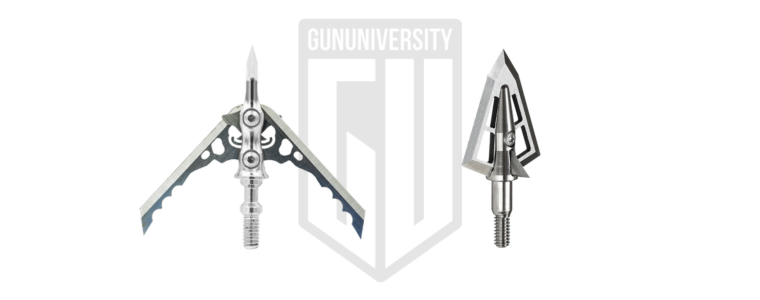
The argument of fixed blade vs mechanical broadheads is an ongoing one in almost every archery forum and that’s for another article. Knowing the difference between fixed blades and mechanical broadheads can help you decide which one is right for you.
- Fixed blade broadheads have been in use for almost 68,000 years, and while the design has improved by leaps and bounds, the core concept is the same. They can have two, three, or even four blades fixed to a ferrule (the center of a broadhead where the blades are attached) or are molded from metal into a particular shape.
- Mechanical broadheads, on the other hand, have retractable mechanical blades. They release these blades from the ferrule when the broadhead strikes a target.
Take a look at the comparison I’ve done below.
| Parameters | Fixed Blade Broadhead | Mechanical Broadhead |
|---|---|---|
| Strength | Fixed blade broadheads are stronger than mechanicals because they don’t have any moving parts. | Mechanical broadheads can lead to more breakage because of their complex construction. |
| Price | Fixed blade broadheads are cheaper. | Mechanical broadheads are more expensive. |
| Reliability | Fixed broadheads are more reliable since they won’t malfunction in the middle of the hunt. | Sometimes, mechanical broadheads fail with blade deployment, either not opening or deploying too early, which can let your quarry escape. |
| Maintenance | One-piece fixed broadheads are usually easy to sharpen and maintain, but ones with removable blades can be a little difficult. | All mechanical broadheads have removable blades, so maintenance can be more time-consuming than fixed blade broadheads. |
| Size | The blades in fixed broadheads are usually smaller to reduce friction when flying. | You can go with bigger blades in mechanical broadheads since it won’t affect the flight. |
At the end of the day, finding the right broadhead is really a matter of preference. Mechanical broadheads are good for you if you want something that doesn’t lose a lot of power in flight and don’t mind the slight chance of them malfunctioning. Otherwise, fixed blade broadheads are a good choice.
What to look for when picking a fixed broadhead?
When buying a broadhead, there are a lot of specs and parameters to keep in mind and it can be hard to figure out which specs are important and which ones don’t matter as much. Here are some of the key specs you need to look for when buying a fixed blade broadhead.
Number of blades – A good rule of thumb for broadheads is that the more blades they have, the bigger the wounds and the better the blood trails. Fixed blade broadheads normally come with two blades, three blades, or four blades, and my recommendation is to go for a three blade broadhead. They have a good three-dimensional shape and can prevent the wound from closing once they go in.
Four blades are similar, but they are also a lot harder to sharpen. Ask yourself if you are willing to spend a bit more time with the sharpening stone every time you want to hunt. If your answer is no, go with the three blades.
But one thing to keep in mind is that broadheads with larger blade area face more air resistance and can easily careen off. So, the more you increase the number and size of the blades, the greater the effect on flight.
Cutting diameter – Cutting diameter is how wide of a wound the broadhead can make. Wide wounds give you better blood trails, making tracking a lot easier, but the problem with fixed blade broadheads that have a large cutting diameter is that they don’t penetrate as well and face more friction while flying.
When looking at cutting diameter, really think about the game you are hunting. Are you hunting elk in Idaho or deer in Alabama? With large game, your bolt should penetrate deep and crush bone, so go with a smaller cutting diameter. For smaller game though, I recommend choosing a broadhead with a larger diameter because they will give you better blood trails.
Blade thickness – A thicker blade can easily cut through your quarry and it is less likely to bend as it passes through the vital organs since it is more durable. A blade between the thickness of 0.020 to 0.0375 inches is what you should look for.
The tip – You can either go with a cut-on-contact or chisel tip. A cut-on-contact broadhead has a bladed tip, while the chisel tip broadhead has a thick pointed hammer-like tip with the blades located behind it.
Again, it depends on the game you are hunting and the bow you use. If you are using a high-poundage bow, a chisel tip would be a good choice for it can crush through bone. But for a low-poundage bow, a cut-on-contact tip can help you create larger wounds.
Material – Stainless steel or aircraft-grade aluminum are usually the best materials for mechanical broadheads and they are also the most common. Other than stainless steel or aluminum, you can also look for one made from high carbon or titanium alloys. They won’t corrode very easily.
Weight in grains – Broadhead weight adds to your arrow weight and the general advice is to go for lighter broadheads for lighter arrows and heavier ones for heavier arrows. Lighter arrows fly faster, but have less penetrative power than heavier arrows. 100 grains is the most common weight you’ll be seeing and, unless you are hunting very large game, that should be plenty!
Legality – Broadheads are heavily regulated and the laws about their usage are different from state to state. Your state has specific laws around what broadheads you can or cannot use, so I recommend looking that up before buying (the Wasp website has compiled the laws for each state) and contacting your state’s gaming board to make sure those are the actual laws in use. The standard fixed broadheads are usually legal in most states and the common requirements for them are to have at least two blades and a minimum width of ⅞ inches.
What you are hunting – So much of your broadhead depends on the game you plan to hunt. If you are hunting large game, you are going to need something that has more penetration, while a broadhead with a large cutting diameter would be a better fit for smaller game.
Best practices in storing and maintaining your broadheads
Broadheads are designed to make a crossbow deadly, and they are a dangerous piece of equipment. There are a lot of things to keep in mind when handling them to make sure you don’t accidentally hurt yourself or anyone else. Here are some safety and maintenance tips on handling your broadheads.
Sharpening your broadhead – A sharp broadhead is dangerous, but I’d say a dull one is worse. If you hunt with a dull broadhead, it will wound your animal instead of killing it. It is not just unethical but also illegal and you really want to avoid this.
The best practice is to sharpen your blades after every practice or hunting session. Here’s how you can do it.
First, mark the sides of the blades on your broadheads with a permanent marker. This will help you make sure each side is equally sharp. Then, attach your broadhead to a shaft and press it against the sharpening stone. Apply a little pressure to remove a bit of metal from each blade and you should be good to go.
Installing your broadhead – Broadheads are razor sharp and you should be very careful when attaching them to your bolt, because you can seriously injure your hands if you mishandle them. The easiest and safest way to do this is to use a broadhead wrench. They are small devices that’ll cover the blades and hold the broadhead in place when you install it. This way, you can keep your hands safe and also prep your bolts more efficiently.
Aligning your broadhead – Always make sure your broadheads are aligned properly, or else you can wave goodbye to your accuracy. Badly aligned broadheads are terrible to shoot with; they don’t fly well, you can lose bolts and they will not be accurate.
To check your broadhead’s alignment, get yourself an arrow spinner. These are two-pronged stands you can rest your arrow on. Place a cardboard box at the tip of your broadhead and slowly spin the arrow using the shaft. If the broadhead is not properly aligned, the point will make a small circle on the cardboard. If your broadhead tip doesn’t move, your arrow is aligned well and you can take it hunting.
Practicing with your broadhead – Before you take your new broadheads, I suggest you practice with them as much as possible until you get the hang of it. This will help you test out their performance and deal with any issues in a safe space. During practice, try to replicate your hunting environment by using the same type of broadheads and practicing from the distance you’re most likely to shoot your game. For example, don’t practice with a Muzzy Trocar at the range and then shoot with the G5 Outdoors Montec when hunting, because each of them will feel different and give you very different results.
Storing your broadhead – Before storing your broadheads, take the time to inspect them for any damage. Pay attention to whether the broadhead blades are bent or broken and carefully examine the ferrule as well. If you’re using replaceable blade broadheads and find that the blades are damaged, you can swap them out with new ones. However, if the ferrule is damaged, it’s best to discard that broadhead.
Once you’ve checked and cleaned the broadheads, it’s time to store them. I use a broadhead case, but some styrofoam in a Tupperware box can do it in a pinch as well. Just make sure your broadheads are secure and in place when you store them.
Conclusion
A good broadhead can make or break your hunt, and spending the time to research and test them can help you find the ones that are just right for you. After all, with hunting gear, it is all about finding what works for you. So, even after reading all the reviews, the best way to find the right broadhead for you is to check them out yourself. Good luck.
Fixed Blade Broadheads – FAQs
My picks for the sharpest fixed blade broadheads are the QAD Exodus and Muzzy Trocar. The QAD Exodus is one of the sharpest fixed blade broadheads out there. It has a massive cutting diameter and leaves large wounds in your quarry. The Muzzy Trocar has a lethal chisel tip and one of the largest cutting diameters I’ve seen in fixed broadheads.
The Muzzy Trocar is one of the deepest penetrating fixed blade broadheads. Its devastating chisel tip and unique design help it penetrate deep into the animal’s body
Yes, you will have to tune your bow and align your fixed blade broadheads. Some of the broadheads will require less tuning than others and fixed broadheads with large cutting diameters can be slightly more difficult to tune.
Replaceable blade heads provide hunters with the flexibility to easily swap out dull or damaged blades without needing to replace the entire broadhead. This can save both time and money, especially during the hunting season when having sharp blades is crucial for effective performance.
While pivoting blades can adjust their angle upon impact for better penetration, fixed blade heads are known for their straight-flight path and consistent accuracy. Many hunters find that fixed blade heads offer more reliable grouping when sighting in their bow, making them a preferred choice for precise shots.
It’s essential to practice with the same type of broadhead you’ll use in the field. While field points can help you sight in your bow, a fixed blade head may fly differently due to its design. Practicing with fixed blade heads will ensure you are familiar with their flight characteristics and can improve your accuracy when it matters most.
Recent Posts
December 8, 2025
November 29, 2025
November 25, 2025
November 22, 2025

